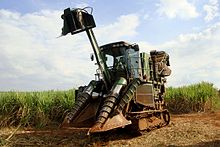Sugar cane harvester

A sugar cane harvester or sugar cane harvester is an agricultural machine for mechanized harvesting of sugar cane . Machines that cut, chop and clean the crop are also known as sugar cane harvesters . Sugar cane harvesters not only enable faster and more efficient harvesting of the sugar cane, but also offer the advantage that the sugar cane can be harvested green. In this way, it is often possible to dispense with burning the fields before the harvest. This protects the soil fauna , reduces the emission of carbon dioxide and makes the harvest time less dependent on weather conditions.
history
The first attempts to harvest sugar cane mechanically were made in the 19th century in Queensland , Australia , which is a center for the mechanization of sugar cane cultivation. The first machine presentations took place here as early as the mid-1920s. The Falkiner Cane Harvester, presented in Bundaberg in 1925, cut off the sugar cane stalks on the ground, removed the unusable foliage at the top and placed the stalks in the field in bundles. Even so, until the early 1960s, sugar cane harvesters were rarely used. The machines often turned out to be unreliable or impractical. This changed within a few years after the brothers Harold and Colin Toft from Bundaberg presented their Toft Cane Harvester in 1961 . A little later, Massey Ferguson also built sugar cane harvesters in Australia. Both companies also exported their machines to other sugar cane producing countries, including Cuba . In the USA , the company CAMECO from Thibodaux in Louisiana produced sugar cane harvesters from 1965. The German agricultural machinery manufacturer Claas developed its first sugar cane harvester in 1971.
While only around 5% of the total sugar cane harvest in Australia was done mechanically in 1961, it was 48.5% in 1966 and 98.5% in 1974. Today, at the beginning of the 21st century, sugar cane is only harvested mechanically in industrial nations such as Australia and the USA. When the sugar price collapsed in 1980, Massey Ferguson stopped producing sugar cane harvesters. The Toft brothers' company was also sold, but was later bought back and has been trading under the Austoft name since 1986 . Austoft has been part of Case since 1996 . CAMECO was taken over by Deere & Company in 1998 . The German company Claas stopped production in 2007.
Today's leading manufacturers of self-propelled sugar cane harvesters - both wheeled and tracked - include John Deere and Case IH . Case sugar cane harvesters are produced in Piracicaba , Brazil , in the middle of a region that is important for cane sugar . The French manufacturer of harvesting equipment for special crops , Simon , manufactures sugarcane harvester, by a tractor drawn.
Working method
The way modern sugar cane harvesters work is similar for all manufacturers and essentially works according to the principle developed by the Toft brothers. These machines are usually self-propelled , equipped with either wheels or crawler tracks.
First of all, the topper separates the stalk below the leaves at the tip, as this upper part cannot be used in sugar production. The topper is located in front of the actual header of the machine at a height of around 250 cm to 500 cm above the ground. It is attached to the machine by means of a boom and is hydraulically adjusted depending on the height of the crop . The topper consists of a horizontally rotating knife, in front of which two star-shaped discs rotating in opposite directions are arranged, which feed the stalk tips to the knife.
The duck header looks similar to the maize header of a forage harvester , but has only two stalk dividers. Conveyor screws run on the stalk dividers, pulling in the sugar cane and lifting it up if necessary. A rotating roller (English: knock-down roller ) pushes the plants forward until they are at the right angle to be pulled into the machine. Two counter-rotating soil knives cut the stems just above the roots. The stem-lift roller (English: butt-lifter roll) transports the crop to the feed rollers. These control the feed with which the sugar cane is transported to the counter-rotating chopping knives, and thus its cutting length. This is around 20 cm to 30 cm; the shorter pieces can be removed more easily than complete stems, as they require less space. After chopping, the pieces of plant fall into the basket , from where they are transferred to a conveyor belt that transports them onto a trailer or truck. A fan separates the crop from dry plant remains, leaves and other impurities. Another cleaning fan is located at the top of the conveyor belt, from where the material falls into the trailer. This separates any remaining impurities. The ejection hood of this secondary separation is adjustable to prevent the residue from being blown into the transport vehicle.
There are devices from smaller manufacturers, especially in India , the People's Republic of China and South Africa , that cut the sugar cane and remove the tips of the leaves, but then deposit the stems in the field. These machines are pulled and driven by a tractor .
Individual evidence
- ↑ http://www.lrrsa.org.au/LRR_SGRa.htm Australia's sugar industry
- ↑ http://australianscreen.com.au/titles/an-australian-invention/ An Australian Invention: Falkiner Cane Harvester in Operation (c1925) - australian screen
- ↑ http://www.powerhousemuseum.com/australia_innovates/?Section_id=1000&article_id=10097&behaviour=view_article Toft cane harvesters - Australia Innovates - Powerhouse Museum
- ^ History ( Memento from April 1, 2008 in the Internet Archive ) Claas Group History
- ↑ http://www.lrrsa.org.au/LRR_SGRa.htm Australia's sugar industry
bibliography
- Australia's sugar industry
- An Australian Invention: Falkiner Cane Harvester in Operation (c1925)
- Toft cane harvesters - Australia Innovates - Powerhouse Museum
- Claas group history


